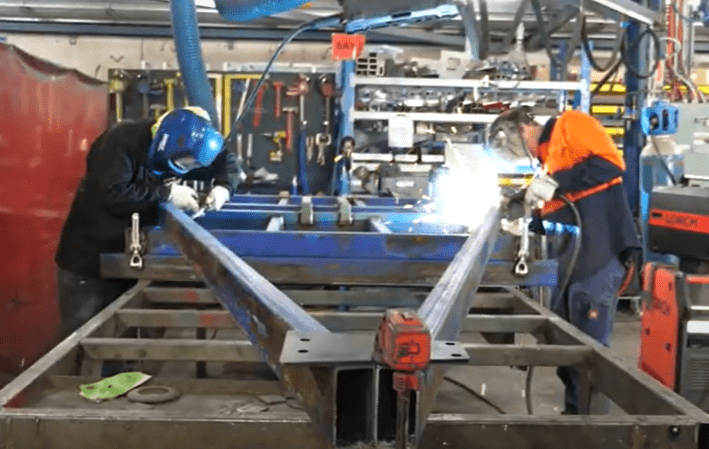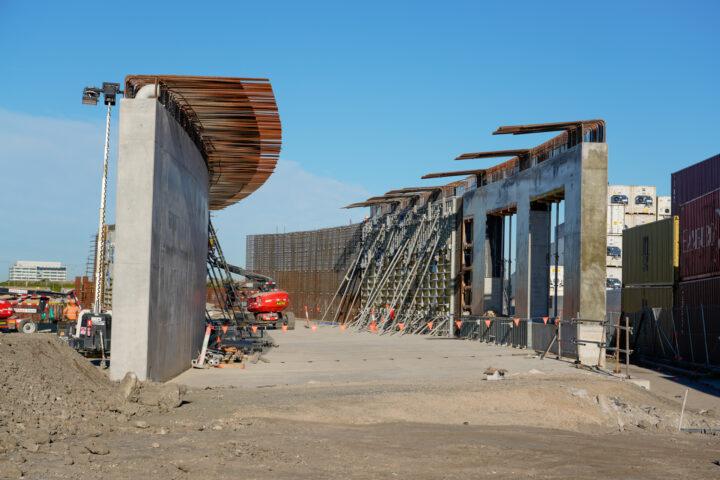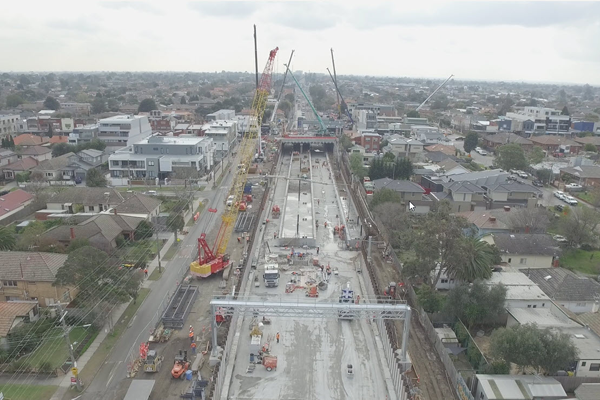
Key Information
Steel has kept Melbourne moving even while its rail network undergoes a much-needed upgrade.
Every growing city must undertake to modernise its public transport infrastructure if it’s to provide for its growing population. When that time comes, the goal is always to provide maximum benefit with greatest cost efficiency – and with as little disruption to usual services as possible.
That point was reached some time ago in Melbourne when the Victorian capital decided to take action to address the traffic congestion and danger to public safety caused by the city’s level crossings.
Across the city, the level crossings in places where the railway network and traffic meet become bottlenecks as cars, cyclists and pedestrians wait for boom gates to rise. At certain points on Melbourne’s busiest train line, the Cranbourne–Pakenham line, it’s estimated that boom gates can remain down for up to 87 minutes during the weekday peak hours of 7am to 9am.
Level crossing removals
In an effort to reduce the impact of Melbourne’s level crossings on the traveling time of motorists and other road users, the Victorian state government has committed to removing 50 level crossings by 2022.
What steps have been taken to ensure Melbourne gets on the move again? The creation of a body dedicated to overseeing the infrastructure pipeline – in this case, the state government’s Level Crossing Removal Authority (LXRA) – has been a factor in keeping the project on track. Assigning works packages to skilled contractors has been another, as has ensuring a regular supply chain of materials.
The prefabrication of those materials has played an important role. The method of prefabricating essential componentry offsite and moving it into place swiftly can increasingly be seen in initiatives such as the level crossing removal project, where speed and efficiency of construction is paramount if to avoid disruption to the public.
Regular services unaffected
The $1.6 billion Caulfield to Dandenong (CTD) Level Crossing Removal Project is one of several works packages underway that the LXRA believes will loosen the shackles on Melbourne’s transport network. Nine dangerous and congested level crossings are being removed by elevating three sections of the line, with all nine crossings to be gone by the end of 2018.
Chris Kafalas, Prefabrication Expert at InfraBuild Construction Solutions (formerly LIBERTY OneSteel Reinforcing), says prefabrication of the concrete piers and crossheads that make up the elevated rail structure has been a factor in the project running to schedule and helped keep train services running throughout the build.
“The important thing to remember with this project, as well as the need to hit deadlines, is you’re working next to live train tracks,” Chris says. “You couldn’t build a substructure under the new railtrack as a working platform because trains are going past constantly – the idea of setting up scaffolding and formwork wasn’t going to be possible.”
He says InfraBuild Construction Solutions worked with the project principals (together called the Alliance, and comprising Lendlease, CPB Contractors, WSP Parsons Brinckerhoff, Aurecon and Metro Trains Melbourne) to devise a solution that allowed for the concrete-and-steel piers that elevate the rail line and crossheads on which the tracks sit to be taken off a truck and placed into position with minimum disruption.
“We worked closely with the project designers at every stage in the process to come up with something that worked for us and them – and in the quickest possible time,” Chris says.
Chris estimates that 4000 tonnes of prefabricated elements were used in the job. That amount makes up an important component of the approximately 40,000 tonnes of steel that the LXRA says will be used across the CTD package.
Lateral thinking applied to prefab
The complexities of the CTD project required an innovative approach to the prefabrication of the reinforcing cages used in both the piers and crossheads.
“We had some really complicated shapes we had to deal with, so we created a jig system that allowed us to place the bars into position,” Chris says. “The jig made it simple for the team not only to create the cage, but to keep it as accurate as possible within the tolerances allowed.”

Each cage had electrical conduits, waterpipes and tensioning bars running through them, which were put in place before the cage was delivered to site.
“Everything was designed in the one piece, so the customer could receive the cage, remove it from the truck, put the formwork around it and pour straight away,” Chris explains.

This casting process took place at a precast yard established specifically for the CTD project. With reinforcing cages in place, the concrete piers and crossheads each consisted of 1.5–2m long box segments weighing approximately 20 tonnes each.
These box segments were then put on a truck and moved the short distance to the construction site, where they were joined together at ground level and stressed to form 40m-long spans. The onsite gantry crane then lifted each span onto its support piers to form the elevated rail deck, with each span then pinned to the support piers with steel fasteners.

Efficiencies in the prefabrication and precasting of important elements of the new rail structure have not only allowed for speedy erection times onsite, but minimised disruption to Melbourne train services and road traffic.
“We took something that would take about 3-4 days to implement on site and it took us 16 hours in our own factory,” Chris says.
Use of local product
The use of Australian-made reinforcing steel is helping the CTD project to meet its sustainability targets and is evidence of the state government’s Victorian Industry Participation Policy in action.
Caulfield to Dandenong Project Director Brett Summers says the project is on target to conform with minimum levels of local steel content to be used in permanent structures.
“The new elevated structure is primarily made up of concrete, so reinforcement steel is being used in foundation piles in the ground all the way through to the structure itself and the elevated deck,” Brett says. “The Alliance continues to align with its commitment to use 92 per cent of Australian steel for permanent works, while the sourcing of overseas products for permanent works has been limited only to very minor rail items including insulated rail joints, points and complex reinforcement steel.”
The use of Australian steel with third party accreditation, as is the case with InfraBuildConstruction Solutions’ prefabricated steel and loose bar, also allows the project to accrue points in the materials category of the Infrastructure Sustainability (IS) rating tool, with the project targeting an ‘Excellent’ rating.
Bringing Melbourne together
In addition to removing congested level crossings along one of Melbourne’s busiest transport corridors, the CTD project is in the process of rebuilding five stations at Carnegie, Murrumbeena, Hughesdale, Clayton and Noble Park. The project will also allow for the lengthening of existing platforms and the upgrading of signalling and power systems to support 65 new longer High Capacity Metro Trains, which will accommodate an extra 20,000 passengers per day when they are introduced progressively from mid-2019.
Urban renewal opportunities
As well as delivering on the project’s transport objectives, the decision by urban designers and engineers to elevate the train line has meant significant opportunities for urban renewal.
Over 225,000 square metres of linear parkland is in the process of being established beneath the train lines, incorporating community activity spaces and 12 kilometres of shared bicycle and walking paths. The aim is to create attractive and safe spaces and avenues that will improve connections between shopping districts, health services and community facilities for the people who live and work nearby.
Brett says the project “isn’t just about cars and trains – it’s about improving the ways available to people to move around their suburbs.
“Anything that encourages kids and families to get out and about is fantastic, and exactly what good infrastructure should be all about,” Brett says.
Reducing traffic congestion is the larger aim. But improving connectivity, strengthening community and ties and establishing tracts of green land are other benefits that will flow from the CTD project and other level crossing removal projects underway in metropolitan Melbourne.
Steel is helping create the city’s new transport infrastructure. But it’s also keeping Melbourne moving during a key period in the city’s transition.
Artist’s impression of Carnegie Station courtesy the LXRA.
Related Case Studies
Subscribe to the
InfraBuild newsletter
Receive regular updates on news, case studies as well as the latest products and services.










